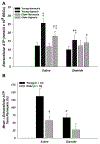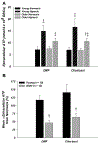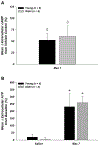Reduced deformability contributes to impaired deoxygenation-induced ATP release from red blood cells of older adult humans
- PMID: 31310005
- PMCID: PMC6717025
- DOI: 10.1113/JP278338
Reduced deformability contributes to impaired deoxygenation-induced ATP release from red blood cells of older adult humans
Abstract
Key points: Red blood cells (RBCs) release ATP in response to deoxygenation, which can increase blood flow to help match oxygen supply with tissue metabolic demand. This release of ATP is impaired in RBCs from older adults, but the underlying mechanisms are unknown. In this study, improving RBC deformability in older adults restored deoxygenation-induced ATP release, whereas decreasing RBC deformability in young adults reduced ATP release to the level of that of older adults. In contrast, treating RBCs with a phosphodiesterase 3 inhibitor did not affect ATP release in either age group, possibly due to intact intracellular signalling downstream of deoxygenation as indicated by preserved cAMP and ATP release responses to pharmacological Gi protein activation in RBCs from older adults. These findings are the first to demonstrate that the age-related decrease in RBC deformability is a primary mechanism of impaired deoxygenation-induced ATP release, which may have implications for treating impaired vascular control with advancing age.
Abstract: In response to haemoglobin deoxygenation, red blood cells (RBCs) release ATP, which binds to endothelial purinergic receptors and stimulates vasodilatation. This ATP release is impaired in RBCs from older vs. young adults, but the underlying mechanisms are unknown. Using isolated RBCs from young (24 ± 1 years) and older (65 ± 2 years) adults, we tested the hypothesis that age-related changes in RBC deformability (Study 1) and cAMP signalling (Study 2) contribute to the impairment. RBC ATP release during normoxia ( ∼112 mmHg) and hypoxia ( ∼20 mmHg) was quantified with the luciferin-luciferase technique following RBC incubation with Y-27632 (Rho-kinase inhibitor to increase deformability), diamide (cell-stiffening agent), cilostazol (phosphodiesterase 3 inhibitor), or vehicle control. The mean change in RBC ATP release from normoxia to hypoxia in control conditions was significantly impaired in older vs. young (∼50% vs. ∼120%; P < 0.05). RBC deformability was also lower in older vs. young as indicated by a higher RBC transit time (RCTT) measured by blood filtrometry (RCTT: 8.541 ± 0.050 vs. 8.234 ± 0.098 a.u., respectively; P < 0.05). Y-27632 improved RBC deformability (RCTT: 8.228 ± 0.083) and ATP release (111.7 ± 17.2%) in older and diamide decreased RBC deformability (RCTT: 8.955 ± 0.114) and ATP release (67.4 ± 11.8%) in young (P < 0.05), abolishing the age group differences (P > 0.05). Cilostazol did not change ATP release in either age group (P > 0.05), and RBC cAMP and ATP release to pharmacological Gi protein activation was similar in both groups (P > 0.05). We conclude that decreased RBC deformability is a primary contributor to age-related impairments in RBC ATP release, which may have implications for impaired vascular control with advancing age.
Keywords: ATP release; deoxygenation; hypoxia; red blood cells.
© 2019 The Authors. The Journal of Physiology © 2019 The Physiological Society.
Conflict of interest statement
Competing interests
None
Figures







Similar articles
-
Rho-kinase inhibition improves haemodynamic responses and circulating ATP during hypoxia and moderate intensity handgrip exercise in healthy older adults.J Physiol. 2022 Jul;600(14):3265-3285. doi: 10.1113/JP282730. Epub 2022 May 29. J Physiol. 2022. PMID: 35575293 Free PMC article. Clinical Trial.
-
The Rho kinase inhibitor Y-27632 increases erythrocyte deformability and low oxygen tension-induced ATP release.Am J Physiol Heart Circ Physiol. 2011 Nov;301(5):H1891-6. doi: 10.1152/ajpheart.00603.2011. Epub 2011 Sep 2. Am J Physiol Heart Circ Physiol. 2011. PMID: 21890695 Free PMC article.
-
Impaired skeletal muscle blood flow control with advancing age in humans: attenuated ATP release and local vasodilation during erythrocyte deoxygenation.Circ Res. 2012 Jul 6;111(2):220-30. doi: 10.1161/CIRCRESAHA.112.269571. Epub 2012 May 29. Circ Res. 2012. PMID: 22647875 Free PMC article.
-
The dual roles of red blood cells in tissue oxygen delivery: oxygen carriers and regulators of local blood flow.J Exp Biol. 2009 Nov;212(Pt 21):3387-93. doi: 10.1242/jeb.023697. J Exp Biol. 2009. PMID: 19837879 Review.
-
Signaling mechanisms in red blood cells: A view through the protein phosphorylation and deformability.J Cell Physiol. 2024 Mar;239(3):e30958. doi: 10.1002/jcp.30958. Epub 2023 Feb 7. J Cell Physiol. 2024. PMID: 36748950 Review.
Cited by
-
Age affects the association of red blood cell indices with efficacy of remote ischemic conditioning in patients with acute moderate ischemic stroke.Sci Rep. 2024 Sep 29;14(1):22561. doi: 10.1038/s41598-024-74293-9. Sci Rep. 2024. PMID: 39343777 Free PMC article.
-
Rho-kinase inhibition improves haemodynamic responses and circulating ATP during hypoxia and moderate intensity handgrip exercise in healthy older adults.J Physiol. 2022 Jul;600(14):3265-3285. doi: 10.1113/JP282730. Epub 2022 May 29. J Physiol. 2022. PMID: 35575293 Free PMC article. Clinical Trial.
-
Heterogeneous ATP patterns in microvascular networks.J R Soc Interface. 2023 Jul;20(204):20230186. doi: 10.1098/rsif.2023.0186. Epub 2023 Jul 19. J R Soc Interface. 2023. PMID: 37464803 Free PMC article.
-
From Cell Architecture to Mitochondrial Signaling: Role of Intermediate Filaments in Health, Aging, and Disease.Int J Mol Sci. 2025 Jan 27;26(3):1100. doi: 10.3390/ijms26031100. Int J Mol Sci. 2025. PMID: 39940869 Free PMC article. Review.
-
Age-related impairments in ATP release by red blood cells as an important contributor to declines in skeletal muscle blood flow in older adults.J Physiol. 2022 Aug;600(16):3643-3645. doi: 10.1113/JP283367. Epub 2022 Jul 21. J Physiol. 2022. PMID: 35818302 Free PMC article. No abstract available.
References
-
- Bergfeld G & Forrester T (1992). Release of ATP from human erythrocytes in response to a brief period of hypoxia and hypercapnia. Cardiovasc Res 26, 40–47. - PubMed
-
- Bowdler A, Dougherty R & Bowdler N (1981). Age as a factor affecting erythrocyte osmotic fragility in males. Gerontology 27, 224–231. - PubMed
Publication types
MeSH terms
Substances
Grants and funding
LinkOut - more resources
Full Text Sources

